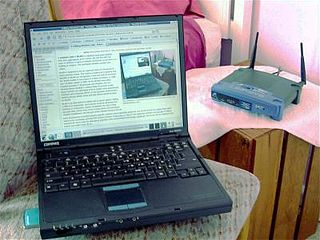
A wireless LAN (WLAN) is a wireless computer network that links two or more devices using wireless communication to form a local area network (LAN) within a limited area such as a home, school, computer laboratory, campus, office building etc. This gives users the ability to move around within the area and yet still be connected to the network. Through a gateway, a WLAN can also provide a connection to the wider Internet.

Wake-on-LAN (WoL) is an Ethernet or token ring computer networking standard that allows a computer to be turned on or awakened by a network message.
Wireless local loop (WLL), is the use of a wireless communications link as the "last mile / first mile" connection for delivering plain old telephone service (POTS) or Internet access to telecommunications customers. Various types of WLL systems and technologies exist.
IEEE 802.1X is an IEEE Standard for port-based Network Access Control (PNAC). It is part of the IEEE 802.1 group of networking protocols. It provides an authentication mechanism to devices wishing to attach to a LAN or WLAN.

In computing, the Preboot eXecution Environment specification describes a standardized client-server environment that boots a software assembly, retrieved from a network, on PXE-enabled clients. On the client side it requires only a PXE-capable network interface controller (NIC), and uses a small set of industry-standard network protocols such as DHCP and TFTP.

WiMAX is a family of wireless broadband communication standards based on the IEEE 802.16 set of standards, which provide multiple physical layer (PHY) and Media Access Control (MAC) options.

A hotspot is a physical location where people may obtain Internet access, typically using Wi-Fi technology, via a wireless local area network (WLAN) using a router connected to an internet service provider.
The IEEE 802.21 refers to Media Independent Handoff (MIH) and is an IEEE standard published in 2008. The standard supports algorithms enabling seamless handover between wired and wireless networks of the same type as well as handover between different wired and wireless network types also called Media independent handover (MIH) or vertical handover. Vertical handover was first introduced by Mark Stemn and Randy Katz at U C Berkeley. The standard provides information to allow handing over to and from wired 802.3 network to wireless 802.11, 802.15, 802.16, 3GPP and 3GPP2 networks through different handover mechanisms.

Wireless security is the prevention of unauthorized access or damage to computers or data using wireless networks, which include Wi-Fi networks. The most common type is Wi-Fi security, which includes Wired Equivalent Privacy (WEP) and Wi-Fi Protected Access (WPA). WEP is a notoriously weak security standard: the password it uses can often be cracked in a few minutes with a basic laptop computer and widely available software tools. WEP is an old IEEE 802.11 standard from 1997, which was superseded in 2003 by WPA, or Wi-Fi Protected Access. WPA was a quick alternative to improve security over WEP. The current standard is WPA2; some hardware cannot support WPA2 without firmware upgrade or replacement. WPA2 uses an encryption device that encrypts the network with a 256-bit key; the longer key length improves security over WEP. Enterprises often enforce security using a certificate-based system to authenticate the connecting device, following the standard 802.1X.
IEEE 802.11u-2011 is an amendment to the IEEE 802.11-2007 standard to add features that improve interworking with external networks.

A computer network is a digital telecommunications network which allows nodes to share resources. In computer networks, computing devices exchange data with each other using connections between nodes. These data links are established over cable media such as wires or optic cables, or wireless media such as Wi-Fi.

Generic Access Network (GAN) is a protocol that extends mobile voice, data and multimedia applications over IP networks. Unlicensed Mobile Access (UMA) is the commercial name used by mobile carriers for external IP access into their core networks. The latest generation system is named Wi-Fi Calling or VoWiFi by a number of handset manufacturers, including Apple and Samsung, a move that is being mirrored by carriers like T-Mobile US and Vodafone. The service is dependant on IMS, IPsec and ePDG.
WISPr or Wireless Internet Service Provider roaming is a draft protocol submitted to the Wi-Fi Alliance that allows users to roam between wireless internet service providers in a fashion similar to that which allows cellphone users to roam between carriers. A RADIUS server is used to authenticate the subscriber's credentials.
Mobile VoIP or simply mVoIP is an extension of mobility to a Voice over IP network. Two types of communication are generally supported: cordless/DECT/PCS protocols for short range or campus communications where all base stations are linked into the same LAN, and wider area communications using 3G/4G protocols.
Network Access Control (NAC) is an approach to computer security that attempts to unify endpoint security technology, user or system authentication and network security enforcement.

Intel Active Management Technology (AMT) is hardware and firmware for remote out-of-band management of select business computers, running on the Intel Management Engine, a separate microprocessor not exposed to the user, in order to monitor, maintain, update, upgrade, and repair them. Out-of-band (OOB) or hardware-based management is different from software-based management and software management agents.

Wireless@SG is a wireless broadband programme developed by the Infocomm Development Authority (IDA) of Singapore as part of its Next Generation National Infocomm Infrastructure initiative, being part of the nation's 10-year masterplan called Intelligent Nation 2015 (iN2015).
Robot as a service is a cloud computing unit that facilitates the seamless integration of robot and embedded devices into Web and cloud computing environment. In terms of service-oriented architecture (SOA), a RaaS unit includes services for performing functionality, a service directory for discovery and publishing, and service clients for user's direct access. The current RaaS implementation facilitates SOAP and RESTful communications between RaaS units and the other cloud computing units. Hardware support and standards are available to support RaaS implementation. Devices Profile for Web Services (DPWS) defines implementation constraints to enable secure Web Service messaging, discovery, description, and eventing on resource-constrained devices between Web services and devices.















